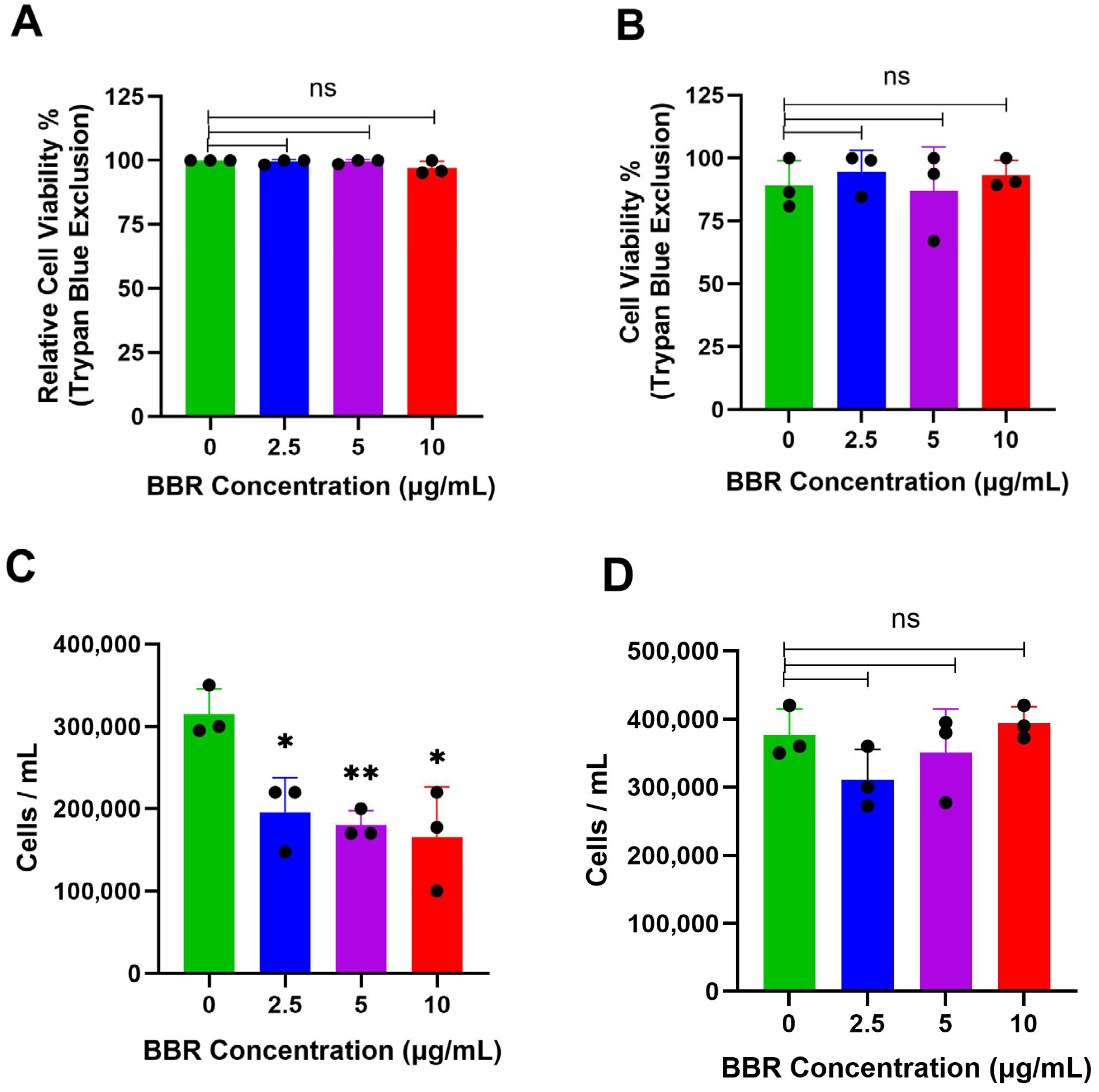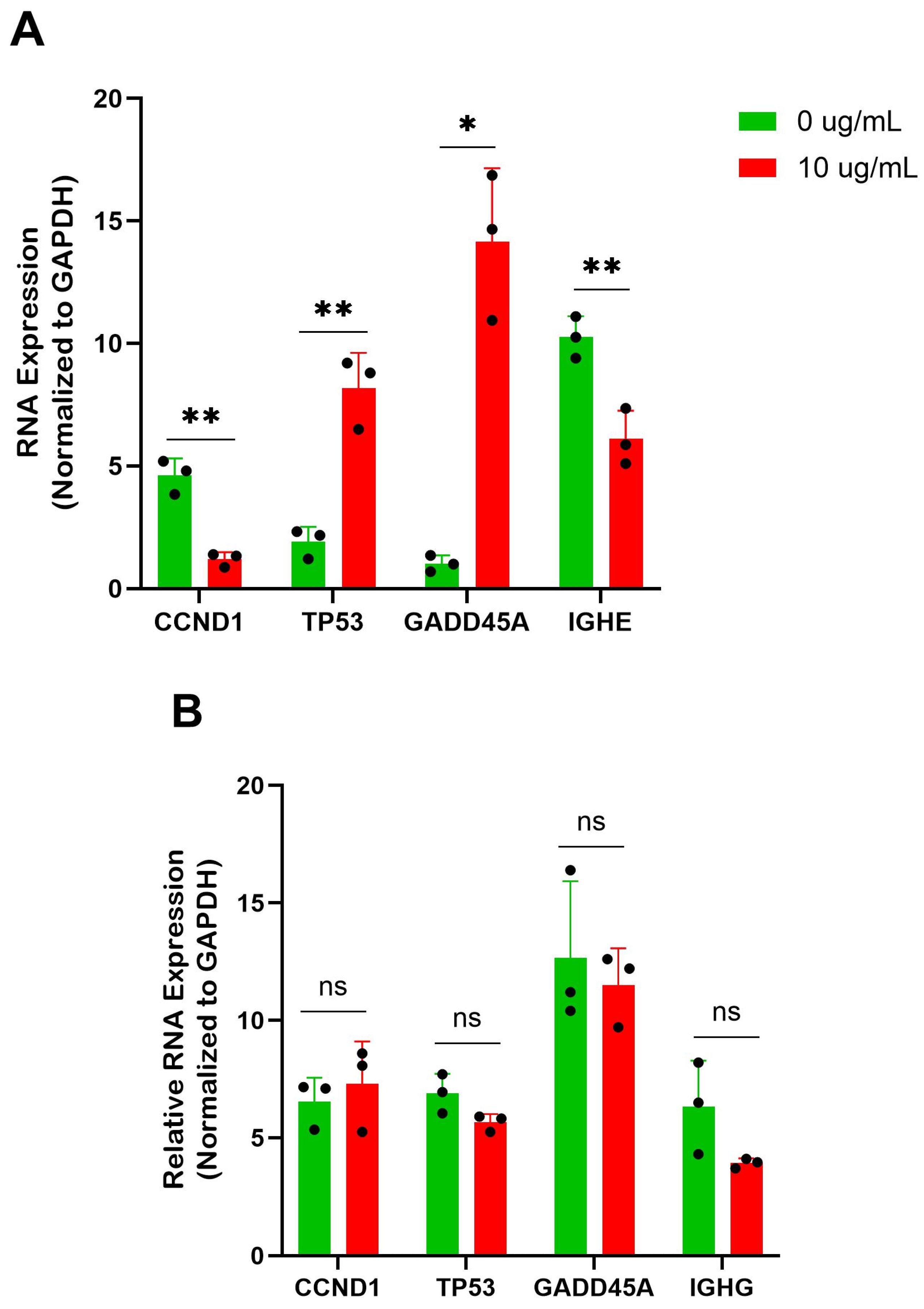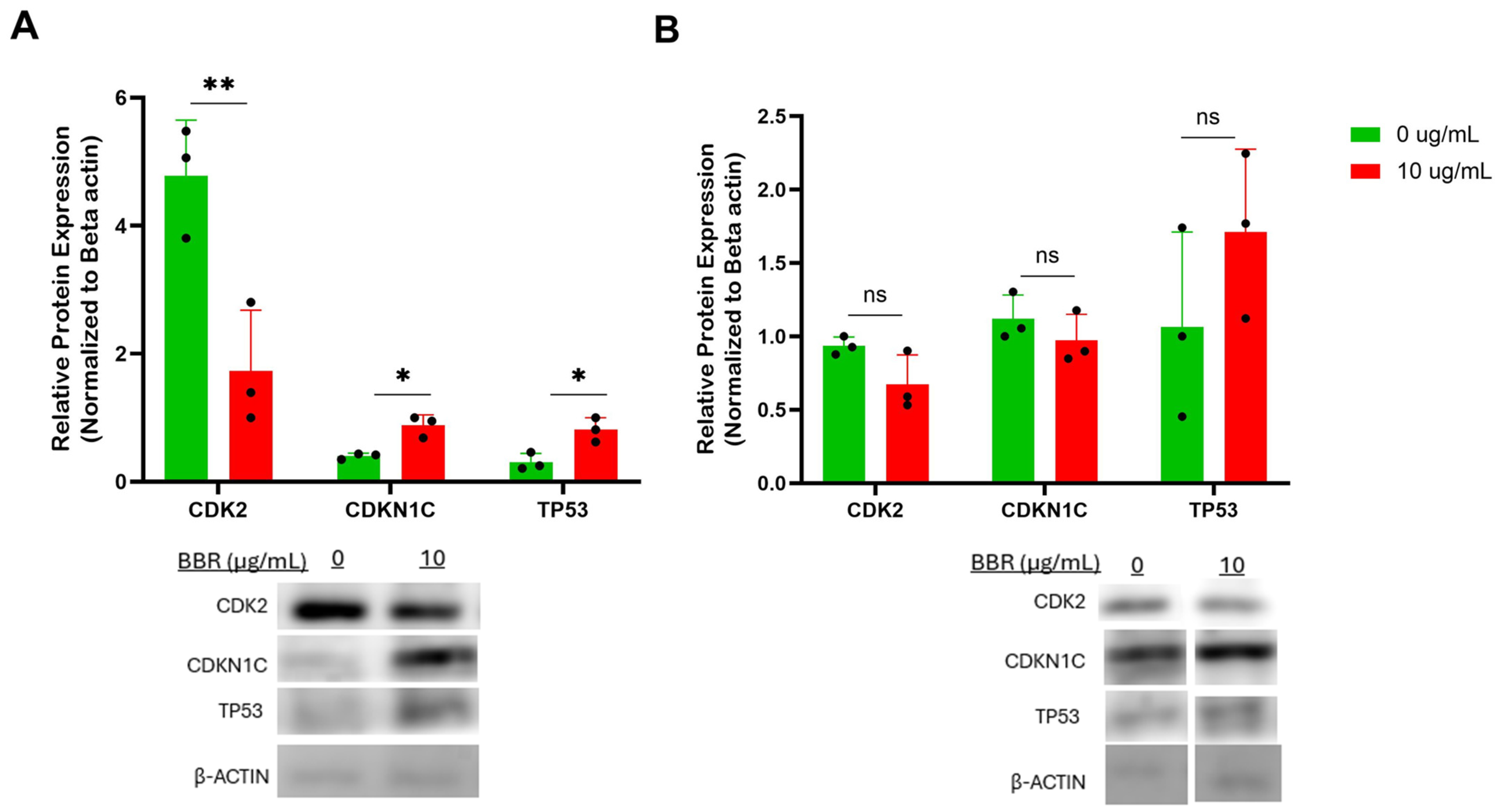A Small Molecule Compound, Berberine Reduces IgE but Not IgG Production via Promoting miRNA-34a-p53 Axis
Abstract
1. Introduction
2. Materials and Methods
2.1. Cell Culture and Treatment
2.2. ELISA
2.3. Cell Viability and Proliferation
2.4. RNA Isolation and qRT-PCR Analysis
2.5. Protein Isolation and Western Blot Analysis
2.6. miRNA Isolation and Analysis
2.7. Statistics
3. Results
3.1. Berberine Inhibits IgE Production in Human Tonsil Samples with No Effect on IgG Production or Cell Viability
3.2. Berberine Inhibits IgE Production with No Effect on IgG Production in Myeloma Cell Lines
3.3. The Reduction in IgE Production by Berberine Is Not Due to the Reduction in Cell Viability of IgE Plasma Cells
3.4. Berberine Treatment Reduced Proliferative Capacity of IgE Plasma Cells with Minimal Effect on IgG Plasma Cells
3.5. Berberine Treatment Alters Cell Cycle and p53 RNA Expression
3.6. Berberine Treatment Alters Protein Expression of Cell Cycle and p53 Pathway
3.7. Non-Coding RNA Regulation of Berberine Treatment in IgE Production
4. Discussion
5. Conclusions
Supplementary Materials
Author Contributions
Funding
Institutional Review Board Statement
Informed Consent Statement
Data Availability Statement
Conflicts of Interest
Abbreviations
| BBR | Berberine |
| BCL-6 | B cell lymphoma 6 |
| CCND1 | Cyclin D1 |
| CDK2 | Cyclin dependent kinase 2 |
| CDKN | Cyclin dependent kinase inhibitor |
| DMSO | Dimethyl sulfoxide |
| FAHF | Food allergy herbal formula |
| FBS | Fetal bovine serum |
| GADD45A | Growth arrest and DNA damage inducible, alpha |
| GAPDH | Glyceraldehyde-3-phosphate dehydrogenase |
| Ig | Immunoglobulin |
| IL | Interleukin |
| lncRNA | Long non-coding RNA |
| MALT1 | Mucosa-associated tissue lymphoma translocation protein-1 |
| MDM4 | Mouse double minute 4 |
| miRNA | MicroRNA |
| ncRNA | Non-coding RNA |
| NFκB | Nuclear factor kappa B subunit |
| qRT-PCR | Quantitative reverse transcriptase polymerase chain reaction |
| RIPA | Radioimmunoprecipitation assay |
| RPMI | Roswell Park Memorial Institute |
| SIRT1 | Sirtuin 1 |
| STAT | Signal transducer and activator of transcription |
| TP53 | Tumor protein 53 |
| XTT | 2,3-Bis-(2-Methoxy-4-Nitro-5-Sulfophenyl)-2H-Tetrazolium-5-Carboxanilide |
References
- U.S. Department of Agriculture. Food Allergies: The “Big 9”. Available online: https://www.fsis.usda.gov/food-safety/safe-food-handling-and-preparation/food-safety-basics/food-allergies-big-9 (accessed on 7 September 2025).
- Network, A.A. A Complete Guide to Allergies. Available online: https://allergyasthmanetwork.org/allergies/ (accessed on 6 September 2025).
- Cildag, S.; Senturk, T. The effect of omalizumab treatment on IgE and other immunoglobulin levels in patients with chronic spontaneous urticaria and its association with treatment response. Postepy Dermatol. Alergol. 2018, 35, 516–519. [Google Scholar] [CrossRef]
- Yang, N.; Maskey, A.R.; Srivastava, K.D.; Kim, M.; Wang, Z.; Musa, I.; Shi, Y.; Gong, Y.; Fidan, O.; Wang, J.; et al. Inhibition of pathologic immunoglobulin E in food allergy by EBF-2 and active compound berberine associated with immunometabolism regulation. Front. Immunol. 2023, 14, 1081121. [Google Scholar] [CrossRef]
- Yang, N.; Wang, J.; Liu, C.; Song, Y.; Zhang, S.; Zi, J.; Zhan, J.; Masilamani, M.; Cox, A.; Nowak-Wegrzyn, A.; et al. Berberine and limonin suppress IgE production by human B cells and peripheral blood mononuclear cells from food-allergic patients. Ann. Allergy Asthma Immunol. 2014, 113, 556–564. [Google Scholar] [CrossRef]
- Srivastava, K.D.; Cao, M.; Fidan, O.; Shi, Y.; Yang, N.; Nowak-Wegrzyn, A.; Miao, M.; Zhan, J.; Sampson, H.A.; Li, X.M. Berberine-containing natural-medicine with boiled peanut-OIT induces sustained peanut-tolerance associated with distinct microbiota signature. Front. Immunol. 2023, 14, 1174907. [Google Scholar] [CrossRef]
- Buell, D.N.; Fahey, J.L. Limited periods of gene expression in immunoglobulin-synthesizing cells. Science 1969, 164, 1524–1525. [Google Scholar] [CrossRef]
- Zhang, Y.; Fear, D.J.; Willis-Owen, S.A.; Cookson, W.O.; Moffatt, M.F. Global gene regulation during activation of immunoglobulin class switching in human B cells. Sci. Rep. 2016, 6, 37988. [Google Scholar] [CrossRef] [PubMed]
- Ramadani, F.; Bowen, H.; Gould, H.J.; Fear, D.J. Transcriptional Analysis of the Human IgE-Expressing Plasma Cell Differentiation Pathway. Front. Immunol. 2019, 10, 402. [Google Scholar] [CrossRef]
- Panganiban, R.P.; Pinkerton, M.H.; Maru, S.Y.; Jefferson, S.J.; Roff, A.N.; Ishmael, F.T. Differential microRNA epression in asthma and the role of miR-1248 in regulation of IL-5. Am. J. Clin. Exp. Immunol. 2012, 1, 154–165. [Google Scholar] [PubMed]
- Yang, N.; Srivastava, K.D.; Chen, Y.; Li, H.; Maskey, A.R.; Yoo, P.; Liu, X.; Tiwari, R.K.; Geliebter, J.; Nowak-Wegrzyn, A.; et al. Sustained silencing peanut allergy by xanthopurpurin is associated with suppression of peripheral and bone marrow IgE-producing B cell. Front. Immunol. 2024, 15, 1299484. [Google Scholar] [CrossRef]
- Musa, I.; Wang, Z.; Yang, N.; Li, X. Formononetin inhibits IgE by huPlasma/PBMCs and mast cell/basophil activation via JAK/STAT/PI3-Akt pathways. Front. Immunol. 2024, 15, 1427563. [Google Scholar] [CrossRef] [PubMed]
- Malumbres, R.; Sarosiek, K.A.; Cubedo, E.; Ruiz, J.W.; Jiang, X.; Gascoyne, R.D.; Tibshirani, R.; Lossos, I.S. Differentiation stage–specific expression of microRNAs in B lymphocytes and diffuse large B-cell lymphomas. Blood 2008, 113, 3754–3764. [Google Scholar] [CrossRef] [PubMed]
- Alashkar Alhamwe, B.; Potaczek, D.P.; Miethe, S.; Alhamdan, F.; Hintz, L.; Magomedov, A.; Garn, H. Extracellular Vesicles and Asthma-More Than Just a Co-Existence. Int. J. Mol. Sci. 2021, 22, 4984. [Google Scholar] [CrossRef]
- Grueso-Navarro, E.; Navarro, P.; Laserna-Mendieta, E.J.; Lucendo, A.J.; Arias-González, L. Blood-Based Biomarkers for Eosinophilic Esophagitis and Concomitant Atopic Diseases: A Look into the Potential of Extracellular Vesicles. Int. J. Mol. Sci. 2023, 24, 3669. [Google Scholar] [CrossRef]
- Okada, N.; Lin, C.-P.; Riberio, M.C.; Biton, A.; Lai, G.; He, X.; Bu, P.; Vogel, H.; Jablons, D.M.; Keller, A.D.; et al. A positive feedback between p53 and miR-34 miRNAs mediates tumor suppression. Genes Dev. 2014, 28, 438–450. [Google Scholar] [CrossRef] [PubMed]
- Nguyen, D.C.; Duan, M.; Ali, M.; Ley, A.; Sanz, I.; Lee, F.E. Plasma cell survival: The intrinsic drivers, migratory signals, and extrinsic regulators. Immunol. Rev. 2021, 303, 138–153. [Google Scholar] [CrossRef]
- Navarro, F.; Lieberman, J. miR-34 and p53: New Insights into a Complex Functional Relationship. PLoS ONE 2015, 10, e0132767. [Google Scholar] [CrossRef]
- Vigorito, E.; Perks, K.L.; Abreu-Goodger, C.; Bunting, S.; Xiang, Z.; Kohlhaas, S.; Das, P.P.; Miska, E.A.; Rodriguez, A.; Bradley, A.; et al. microRNA-155 regulates the generation of immunoglobulin class-switched plasma cells. Immunity 2007, 27, 847–859. [Google Scholar] [CrossRef]
- Basso, K.; Schneider, C.; Shen, Q.; Holmes, A.B.; Setty, M.; Leslie, C.; Dalla-Favera, R. BCL6 positively regulates AID and germinal center gene expression via repression of miR-155. J. Exp. Med. 2012, 209, 2455–2465. [Google Scholar] [CrossRef]
- Lu, D.; Nakagawa, R.; Lazzaro, S.; Staudacher, P.; Abreu-Goodger, C.; Henley, T.; Boiani, S.; Leyland, R.; Galloway, A.; Andrews, S.; et al. The miR-155-PU.1 axis acts on Pax5 to enable efficient terminal B cell differentiation. J. Exp. Med. 2014, 211, 2183–2198. [Google Scholar] [CrossRef] [PubMed]
- Borbet, T.C.; Hines, M.J.; Koralov, S.B. MicroRNA regulation of B cell receptor signaling. Immunol. Rev. 2021, 304, 111–125. [Google Scholar] [CrossRef]
- Guo, Q.; Zhang, J.; Li, J.; Zou, L.; Zhang, J.; Xie, Z.; Fu, X.; Jiang, S.; Chen, G.; Jia, Q.; et al. Forced miR-146a expression causes autoimmune lymphoproliferative syndrome in mice via downregulation of Fas in germinal center B cells. Blood 2013, 121, 4875–4883. [Google Scholar] [CrossRef]
- Hernández Borrero, L.J.; El-Deiry, W.S. Tumor suppressor p53: Biology, signaling pathways, and therapeutic targeting. Biochim. Biophys. Acta Rev. Cancer 2021, 1876, 188556. [Google Scholar] [CrossRef]
- Villamañán, E.; Laorden, D.; Granda, P.; Sobrino, C.; De Andrés, S.; Carpio, C.; Domínguez-Ortega, J.; Romero, D.; Mariscal, P.; De Las Vecillas, L.; et al. Current Biologic Therapies for Severe Asthma and Real-World Data: Are Expectations Being Met? J. Clin. Med. 2024, 13, 7152. [Google Scholar] [CrossRef] [PubMed]
- Luo, G.; Gao, M.; Lin, Q. Integration of bioinformatics analysis, molecular docking and animal experiments to study the therapeutic mechanisms of berberine against allergic rhinitis. Sci. Rep. 2024, 14, 11999. [Google Scholar] [CrossRef] [PubMed]
- Maskey, A.R.; Carnazza, M.; Spears, M.; Hemmindinger, S.; Kopulos, D.; Yang, N.; Islam, H.K.; Moscatello, A.L.; Geliebter, J.; Tiwari, R.K.; et al. Berberine Suppression of Human IgE but Not IgG Production via Inhibition of STAT6 Binding Activity at IgE Promoter by BCL6. Cells 2025, 14, 591. [Google Scholar] [CrossRef] [PubMed]
- O’Brien, J.; Hayder, H.; Zayed, Y.; Peng, C. Overview of MicroRNA Biogenesis, Mechanisms of Actions, and Circulation. Front. Endocrinol. 2018, 9, 402. [Google Scholar] [CrossRef] [PubMed]
- Alnugaydan, A.M. Targeting micro-RNAs by natural products: A novel future therapeutic strategy to combat cancer. Am. J. Transl. Res. 2020, 12, 3531–3556. [Google Scholar]
- Yarahmadi, S.; Sotoudeheian, M.; Farahmandian, N.; Mohammadi, Y.; Koushki, M.; Babaeenezhad, E.; Yousefi, Z.; Fallah, S. Effect of resveratrol on key signaling pathways including SIRT1/AMPK/Smad3/TGF-β and miRNA-141 related to NAFLD in an animal model. Res. Pharm. Sci. 2025, 20, 434–444. [Google Scholar] [CrossRef] [PubMed]
- Chen, J.; Xiong, D.; Long, M. Curcumin Attenuates Fumonisin B1-Induced PK-15 Cell Apoptosis by Upregulating miR-1249 Expression to Inhibit the IRE1/MKK7/JNK/CASPASE3 Signaling Pathway. Antioxidants 2025, 14, 168. [Google Scholar] [CrossRef]
- Qin, H.; Song, Z.; Zhao, C.; Li, S.; Ali, A.; Zheng, W. miR-363-3p/PTEN is involved in the regulation of lipid metabolism by genistein in HepG2 cells via ERβ. Phytomedicine 2023, 115, 154839. [Google Scholar] [CrossRef]
- Yang, X.; Jiang, W.; Kong, X.; Zhou, X.; Zhu, D.; Kong, L. Genistein Restricts the Epithelial Mesenchymal Transformation (EMT) and Stemness of Hepatocellular Carcinoma via Upregulating miR-1275 to Inhibit the EIF5A2/PI3K/Akt Pathway. Biology 2022, 11, 1383. [Google Scholar] [CrossRef]
- Dharshini, L.C.P.; Mandal, A.K.A. Regulation of gene expression by modulating microRNAs through Epigallocatechin-3-gallate in cancer. Mol. Biol. Rep. 2024, 51, 230. [Google Scholar] [CrossRef]
- Ramos, Y.A.L.; Souza, O.F.; Novo, M.C.T.; Guimarães, C.F.C.; Popi, A.F. Quercetin shortened survival of radio-resistant B-1 cells in vitro and in vivo by restoring miR15a/16 expression. Oncotarget 2021, 12, 355–365. [Google Scholar] [CrossRef]
- Lao, X.; Gu, J.; Zhu, R.; Feng, M.; Zhu, X.; Li, Y.; Fei, J. Integrative analysis of differential miRNA and functional study of miR-21 by seed-targeting inhibition in multiple myeloma cells in response to berberine. BMC Syst. Biol. 2014, 8, 82. [Google Scholar] [CrossRef] [PubMed]
- Feliciano, A.; Sánchez-Sendra, B.; Kondoh, H.; Lleonart, M.E. MicroRNAs Regulate Key Effector Pathways of Senescence. J. Aging Res. 2011, 2011, 205378. [Google Scholar] [CrossRef]
- Capaccia, C.; Diverio, S.; Zampini, D.; Guelfi, G. The Complex Interaction Between P53 and miRNAs Joins New Awareness in Physiological Stress Responses. Cells 2022, 11, 1631. [Google Scholar] [CrossRef] [PubMed]
- Hüllein, J.; Słabicki, M.; Rosolowski, M.; Jethwa, A.; Habringer, S.; Tomska, K.; Kurilov, R.; Lu, J.; Scheinost, S.; Wagener, R.; et al. MDM4 Is Targeted by 1q Gain and Drives Disease in Burkitt Lymphoma. Cancer Res. 2019, 79, 3125–3138. [Google Scholar] [CrossRef] [PubMed]
- Gembarska, A.; Luciani, F.; Fedele, C.; Russel, E.; Dewaea, M.; Villar, S.; Zwolinska, A.; Haupt, S.; de Lange, J.; Yip, D.; et al. MDM4 is a key therapeutic target in cutaneous melanoma. Nat. Med. 2012, 18, 1239–1247. [Google Scholar] [CrossRef]
- Cui, B.; Chen, L.; Zhang, S.; Mraz, M.; Fecteau, J.; Yu, J.; Ghia, E.; Zhang, L.; Bao, L.; Rassenti, L.; et al. MicroRNA-155 influences B-cell receptor signaling and associates with aggressive disease in chronic lymphocytic leukemia. Blood 2014, 124, 546–554. [Google Scholar] [CrossRef]
- Bouamar, H.; Jiang, D.; Wang, L.; Lin, A.; Ortega, M.; Aguiar, R. MicroRNA 155 control of p53 activity is context dependent and mediated by Aicda and Socs1. Mol. Cell. Biol. 2015, 35, 1329–1340. [Google Scholar] [CrossRef]
- Pan, J.; Tang, Y.; Yu, J.; Zhang, J.; Wang, C.; Gu, J. miR-146a attenuates apoptosis and modulates autophagy by targeting TAF9b/P53 pathway in doxorubicin-induced cardiotoxicity. Cell Death Dis. 2009, 10, 1–15. [Google Scholar] [CrossRef] [PubMed]
- Wang, F.; Kong, L.; Pu, Y.; Chao, F.; Zang, C.; Qin, W.; Zhao, F.; Cai, S. Long Noncoding RNA DICER1-AS1 Functions in Methylation Regulation on the Multi-Drugresistance of Osteosarcoma Cells via miR-34a-5p and GADD45A. Front. Oncol. 2021, 11, 685881. [Google Scholar] [CrossRef] [PubMed]
- Palomer, X.; Salvador, J.; Grinan-Ferre, C.; Barroso, E.; Pallas, M.; Vazquez-Carrera, M. GADD45A: With or without you. Med. Res. Rev. 2023, 44, 1375–1403. [Google Scholar] [CrossRef]
- Barreto, G.; Schafer, A.; Marhold, J.; Stach, D.; Swaminathan, S.; Handa, V.; Doderlein, G.; Maltry, N.; Wu, W.; Lyko, F.; et al. Gadd45a promotes epigenetic gene activation by repair-mediated DNA demethylation. Nature 2007, 2007, 671–675. [Google Scholar] [CrossRef]
- Andoh, T.; Yoshihisa, Y.; Rehman, M.U.; Tabuchi, Y.; Shimizu, T. Berberine induces anti-atopic dermatitis effects through the downregulation of cutaneous EIF3F and MALT1 in NC/Nga mice with atopy-like dermatitis. Biochem. Pharmacol. 2021, 185, 114439. [Google Scholar] [CrossRef]
- Ferrero, G.; Carpi, S.; Polini, B.; Pardini, B.; Nieri, P.; Impeduglia, A.; Grioni, S.; Tarallo, S.; Naccarati, A. Intake of Natural Compounds and Circulating microRNA Expression Levels: Their Relationship Investigated in Healthy Subjects with Different Dietary Habits. Front. Pharmacol. 2021, 11, 619200. [Google Scholar] [CrossRef]
- Suzuki, K.; Murphy, S.H.; Xia, Y.; Yokota, M.; Nakagomi, D.; Liu, F.; Verma, I.M.; Nakajima, H. Tumor suppressor p53 functions as a negative regulator in IgE-mediated mast cell activation. PLoS ONE 2011, 6, e25412. [Google Scholar] [CrossRef] [PubMed]








Disclaimer/Publisher’s Note: The statements, opinions and data contained in all publications are solely those of the individual author(s) and contributor(s) and not of MDPI and/or the editor(s). MDPI and/or the editor(s) disclaim responsibility for any injury to people or property resulting from any ideas, methods, instructions or products referred to in the content. |
© 2025 by the authors. Licensee MDPI, Basel, Switzerland. This article is an open access article distributed under the terms and conditions of the Creative Commons Attribution (CC BY) license (https://creativecommons.org/licenses/by/4.0/).
Share and Cite
Carnazza, M.; Spears, M.; Tiwari, R.K.; Geliebter, J.; Yang, N.; Li, X.-M. A Small Molecule Compound, Berberine Reduces IgE but Not IgG Production via Promoting miRNA-34a-p53 Axis. Cells 2025, 14, 1799. https://doi.org/10.3390/cells14221799
Carnazza M, Spears M, Tiwari RK, Geliebter J, Yang N, Li X-M. A Small Molecule Compound, Berberine Reduces IgE but Not IgG Production via Promoting miRNA-34a-p53 Axis. Cells. 2025; 14(22):1799. https://doi.org/10.3390/cells14221799
Chicago/Turabian StyleCarnazza, Michelle, Madison Spears, Raj K. Tiwari, Jan Geliebter, Nan Yang, and Xiu-Min Li. 2025. "A Small Molecule Compound, Berberine Reduces IgE but Not IgG Production via Promoting miRNA-34a-p53 Axis" Cells 14, no. 22: 1799. https://doi.org/10.3390/cells14221799
APA StyleCarnazza, M., Spears, M., Tiwari, R. K., Geliebter, J., Yang, N., & Li, X.-M. (2025). A Small Molecule Compound, Berberine Reduces IgE but Not IgG Production via Promoting miRNA-34a-p53 Axis. Cells, 14(22), 1799. https://doi.org/10.3390/cells14221799






